(May 24, 2019) Update: I have updated this review with the new Drawing Tests section which I have recently started doing in my reviews.
The conclusion of this review is unchanged. I still believe this tablet is a very good option.
Update (Dec. 05, 2018): I am extremely happy to announce that the firmware update has straightened the wobbly lines for my unit! I will talk in more detail about that in The Drawing Experience! section.
Update (Nov. 29, 2018): I have been notified that they have a new firmware update coming next week which addresses the wobbly lines. I look forward to seeing if it actually works!
Update (Nov. 19, 2018): Err, I was having too much fun taking apart my Huion tablet pens, and ended up breaking my PW507 pen. I put an order in for a replacement, but it probably won’t arrive before November 23, so I’ll ask Huion whether they’ve found a fix for the wobbly lines when I receive my replacement pen (because I can’t test the wobbly lines otherwise). Whoopsie.
Update (Oct. 23, 2018): Huion support has told me they are working to fix the wobbly line issue and are hopeful that they can fix it within the next month. They have told me they will update me if they fix the issue before then, but otherwise, I will contact them myself sometime around November 23, 2018 to hear what they have figured out about the issue.
The Huion Kamvas Pro 13 is Huion’s newest tablet with a fully-laminated textured screen, 120% sRGB colour gamut, battery-free pen, and pen tilt functionality. From just looking at the specs, this tablet is quite appealing with top of the line features across the board and a competitive price.
This is their first 13-inch drawing monitor because previously, Huion was always more interested in creating larger tablets in the 19 to 22-inch range. I am happy that they decided it was worthwhile to release a 13-inch tablet because I personally never really needed drawing monitors larger than 15.6-inch, especially while they still only offer 1920x1080p resolution which can look pixellated on larger monitors when viewed up close to draw.
At first, I was quite skeptical and thought the specs for this tablet were too good to be true due to previous disappointments with tablets which did not live up to their specs. However, I will put this out there before I even start my review… This tablet did not disappoint.
For this review, Huion was kind enough to supply me with the Huion Kamvas Pro 13. As usual, this review is based on my honest thoughts and opinions about the tablet and I will never agree to review a product if I am required to say only good things about it.
If you believe receiving a review product for free makes a review biased, now is a perfect time for you to stop reading.
Anyways, onto the review!
Credit to my friend, David, for the photos in this review. You can check him out on Instagram at https://www.instagram.com/ikindaforgot/.
Please note!
-I am not a Mac or Linux user!! I only tested this tablet on Windows 8.1 and Windows 10.
-Prices may have changed since I wrote this review.
-Check when a review was written. Some aspects may improve or change over time, so it is in your best interest to concentrate on reviews which are less than 1 year old.
-Always check multiple reviews to cross reference their information before you make a conclusion about a tablet.
Table of Contents
- How good is this tablet?
- Specifications at a glance
- What’s in the box?
- Screen quality
- Tablet drivers
- Drawing tests
- The drawing experience!
- Conclusion
- Places to buy the tablet
How good is this tablet?
Design choices: Mostly great!
-Nitpicks: Power button placement, outlet is necessary for power
Hardware quality: Very sturdy!
-Nitpicks:
Screen quality: Really good!
-Nitpicks:
Tablet drivers: Well featured!
-Nitpicks: No anti-ghosting on shortcut buttons, calibration tool is a pain to use
Drawing test results: Pretty fantastic!
-Nitpicks:
Actual drawing experience: Very enjoyable!
-Nitpicks:
Overall: Amazing! No actual issues, just small nitpicks here and there.
Update (Dec. 05, 2018): The wobbly line issue has been fixed (for my unit) with a firmware update. I will talk in more detail about that in The Drawing Experience! section.
My verdict:
-If you are considering this tablet, it is an extremely good option and it certainly gets my recommendation. I believe this tablet is a very good alternative to the Wacom Cintiq 13HD, and maybe even a decent alternative to the newer Wacom Cintiq Pro 13. I have a few nitpicks which I will talk about in the review, but this tablet is a pretty solid choice overall.
Important specifications
Price: 399.00 USD (when this review was written)
Active Area: 11.5 x 6.5 inches, 13.3 inch diagonal
Resolution: FHD 1920 x 1080 (16:9 ratio)
Display Type: IPS, gamut = 120% sRGB on product page
Pen Type: Battery-free
Pen Buttons: 2 side buttons, no eraser
Pen Pressure: 8192
Pen Tilt Sensitivity: Yes, +-60 levels
Expresskeys: 4 buttons, 1 touch bar
Multi-touch: No
What’s in the box?
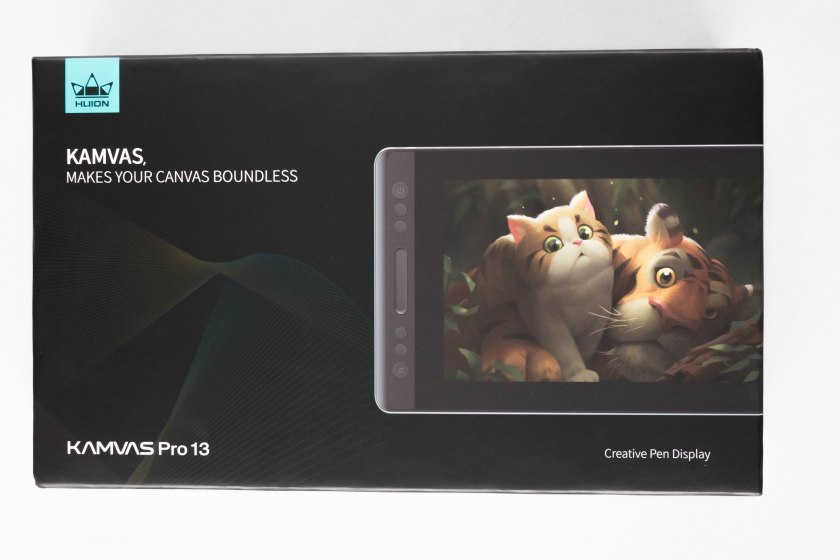
The tablet comes in a nice looking black box with a preview of the tablet on the front.

The things that come in the box:
- Huion Kamvas Pro 13 Tablet
- Tablet stand
- Battery-free pen
- Pen stand
- Combined cable (USB type-C to USB type-A, HDMI, and power)
- Pen nib replacements x10
- Screen cleaning cloth
- User manual
- Driver installation CD shaped instruction card
- Warranty card
- “Thank you” card
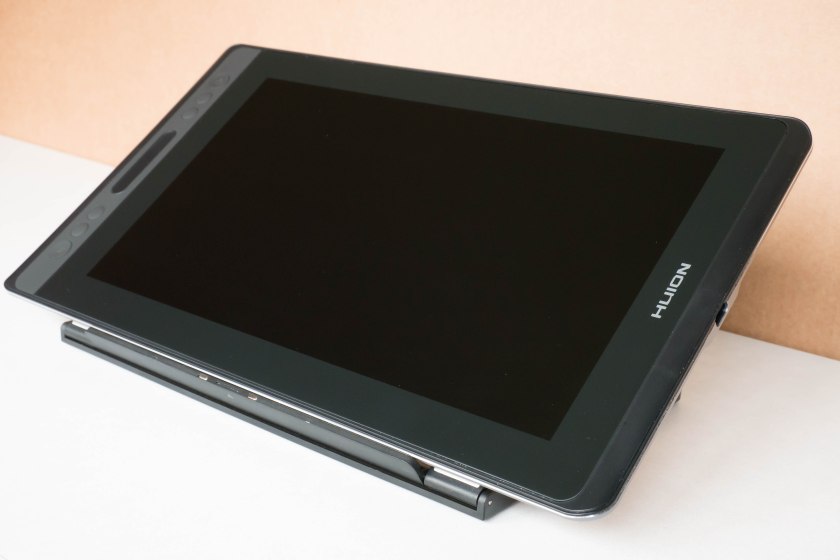
The Huion Kamvas Pro 13 is a fairly nice looking tablet with a dark colour scheme on the front with a silver rim.
The screen comes textured out of the box and has a nice smooth matte texture. This texture helps give resistance against the pen while drawing to make it easier to control your strokes. It also works as an anti-glare texture to prevent glare from light reflecting off the screen.
This texture has been applied directly to the screen and is not a screen protector so you cannot take it off.
It should be noted that I do not see any scratches or worn out areas on the screen despite drawing on it intensively for almost 2 weeks. The pen nib also has not worn down at all despite the screen being textured.
The tablet feels decently sturdy when twisting it between my hands, and I do not think it will break easily from normal use. When I twist harder, it does creak a bit, but I believe that is normal and happens because of how thin the tablet is made. I have no reason to believe it will break quickly from my experience using it intensively for a week and a half.
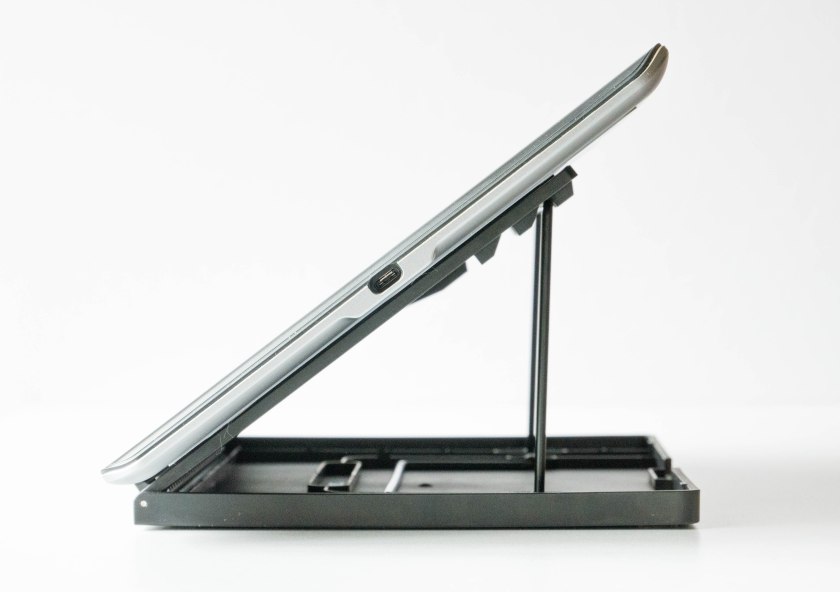
This tablet is very thin and should be able to fit in any 15.6-inch laptop bag. If you need a tablet which you can bring from one workplace to another, this tablet and the stand should easily fit in your bag alongside your laptop.
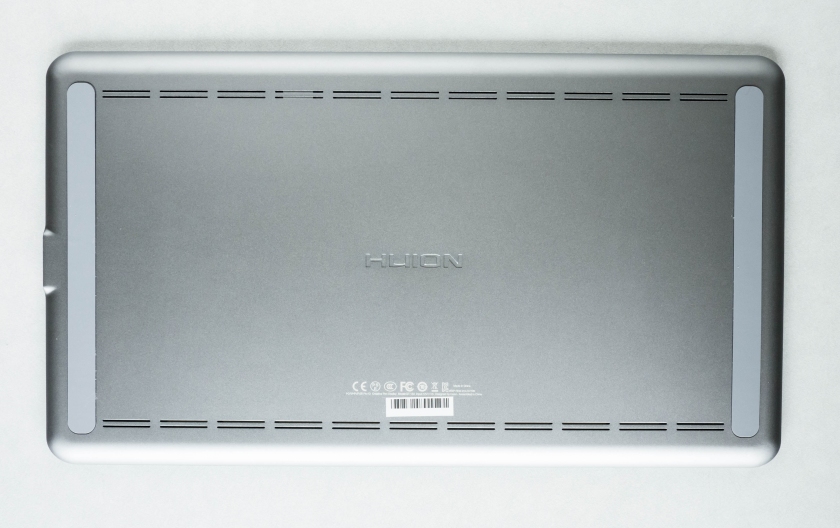
The back of the tablet is made of a silver material which feels hard and cool to the touch. I’m a bit too inexperienced with materials to know for sure, but from the info on the product page I believe this is a type of aluminum alloy, meaning this tablet is made quite durably with a metal casing for the back.
On the back are two long rubber feet on both sides of the tablet. If you are using this tablet without the tablet stand, those rubber feet will keep the tablet in place on your desk.
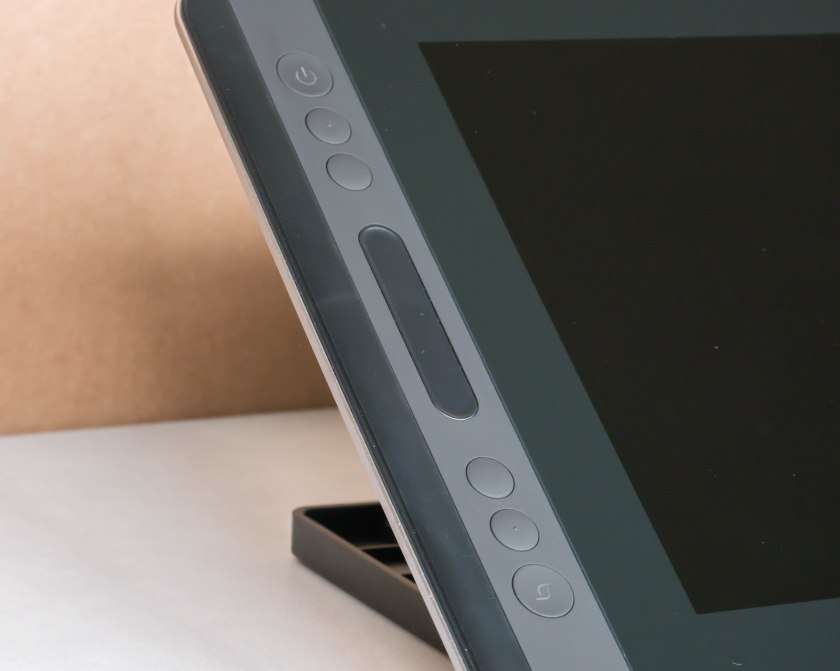
There are 4 programmable buttons and 1 touch bar along the side of the tablet. The two bigger buttons at the top and bottom are unprogrammable with one of them being the power button, and the other being the function switch and OSD settings button. I will talk more about how to access the OSD settings using this button in the Screen Quality section.
The buttons give a nice tactile click while not being too hard to press. I have always liked how Huion’s shortcut buttons feel, and the shortcut buttons on this tablet are no different.
If I had to nitpick, it’s a bit weird that the power button is placed right beside the shortcut buttons. This didn’t actually happen to me, but isn’t it completely possible that people will accidentally press the power button when going to press the very top shortcut button?
Personally, I feel like the power button could have been placed somewhere else, and that space could have instead been used for more shortcut buttons.
Another thing to note is that Huion shortcut keys do not have anti-ghosting capabilities. In other words, you cannot use two buttons at the same time. This will not matter in most cases, but you should keep this in mind if you think it affects you.
The tablet has a single USB type-C connection port on it. This is a great design choice because this means that the L-shaped cable can be flipped for left-handed use. This is because USB type-C ports are symmetrical and can be plugged in either direction.
Unfortunately, I do not have a USB type-C port on any of my computers, so I cannot test how the tablet will behave when connected with a single USB type-C cable.
The included cable is a combined cable which goes from the USB type-C on the tablet to USB type-A and HDMI on the computer, and a longer cable to a power outlet. The cable must be connected to a power outlet or else the tablet will not power on.
It is a bit inconvenient that the power cable must be connected for the tablet to work considering that many other 13-inch tablets can be powered through USB without connecting to a power outlet (ex. XP-Pen Artist 13.3, Artisul D13, and Parblo Coast13), but if you think about it, it’s not really a problem.
Unless you intend to draw without connecting your laptop to a power outlet, you should usually be able to connect your tablet to a power outlet too. If you intend to draw without a power outlet nearby, you should be getting something made for portability like an iPad Pro + Apple Pencil instead of a drawing monitor anyways.
The USB type-A and HDMI can reach around 60cm apart from each other, so it should be able to accommodate most normal workspaces and reach around most laptops, even if the HDMI and USB type-A ports are not right beside each other on your computer.
There is also a Velcro strip on the cable to help put them away neatly when you need to. This is a non-painful type of Velcro which doesn’t hurt when you touch it.
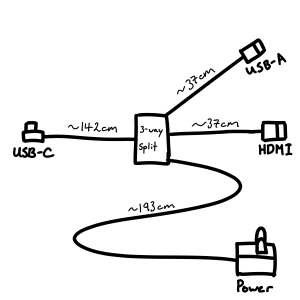
As I was asked by a commenter what the actual measurements of the cable are, so I created the above rough diagram to show the lengths corresponding to the parts of the cable.
So the cable is ~142cm from the USB type-C to the 3-way split, then ~37cm from the 3-way split to the USB type-A and HDMI. The length of the power cable from the 3-way split is ~193cm.
The tablet stand is made with a metal front plate and plastic everywhere else. There are rubber pads on the front plate and on the base and the tablet did not slide at all while I was drawing.
This tablet stand comes included in the box with the tablet.
The way this tablet stand is designed, it supports 6 different positions, 3 slots for each of the 2 metal arms. The rough angles this stand can achieve are: 15, 20, 25, 35, 40, 45 degrees. There is no upright position with this stand. I used the 25 degree angle the most for my setup.
When I first received the tablet, one of the metal rods on the tablet stand was not properly put in its hole, but I just slid it into its proper position and it was fixed.
The tablet comes with a premium looking battery-free pen with a nice rubber grip, plastic body, and silver accents. It has a subtle taper as well as a bulge near the tip which makes it very comfortable to hold and use.
The pen buttons protrude slightly from the surface of the pen making them very easy to find and use. They are very nice to use because they have a nice tactile click which doesn’t require too much effort to press.
Surprisingly, the rubber which they used for the grip did not become slippery despite me using it after applying hand cream. It also does not collect dust and can easily be cleaned off. The rubber which Huion decided to use for this pen grip is fantastic.
The top of the pen does not have anything.
This is the pen stand which comes with this tablet. It can hold the pen upright, or sideways by wedging the pen in the indent on the top. It has a rubber base so it does not slide or move around at all.
The replacement pen nibs are inside the pen stand, and the pen nib remover is also held snugly in the middle. Although there are 10 pen nib replacements, I have yet to see any wearing on my first pen nib after a week and a half of use.
Screen quality
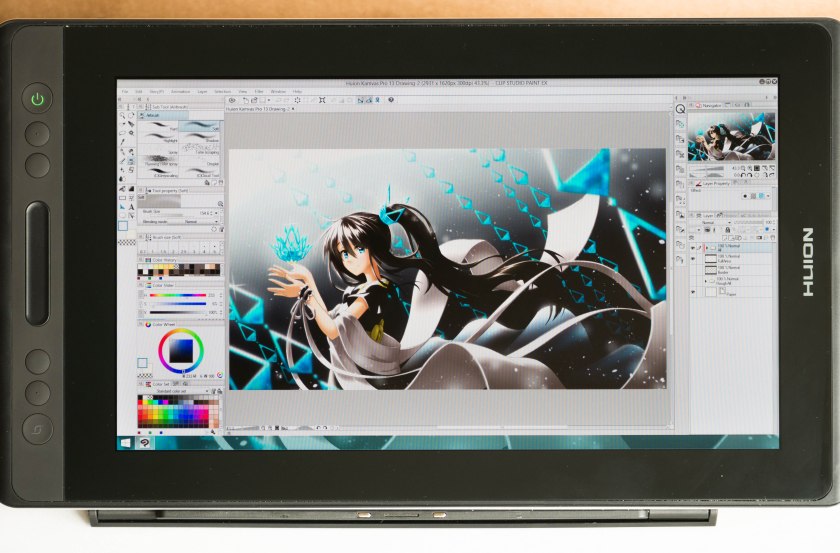
(The lines on the screen in the photo above are caused by the camera, not the tablet. There are no visible lines on the screen when viewed with the naked eye.)
The Huion Kamvas Pro 13 has fairly good screen colours out of the box. As expected, they are not calibrated, but the default settings are okay nonetheless albeit a bit strong on the blues.
Unfortunately, due to Nvidia settings, the colours on the screen are actually a bit washed out at first. This is an issue that almost all tablets which use HDMI have as the Nvidia drivers automatically assume that a monitor connected through HDMI is a TV and will apply limited colour settings as such.

To fix this, open the Nvidia Control Panel. You can do this by right-clicking on your desktop and selecting ‘Nvidia Control Panel’ there.
From there, go to the ‘Change resolution’ section in the left side-bar, then select the tablet.
Next, scroll down to the 3rd section and select ‘Use NVIDIA color settings’, then change ‘Output color format:’ to RGB, and ‘Output dynamic range:’ to Full, then click Apply.
AMD graphic card users can also do this by going into their ‘AMD Radeon Settings’, then going to the ‘Display’ section and setting the Pixel Format to ‘RGB (full RGB)’.
With that change, the tablet should now display its full range of colours and should no longer look washed out.

To access the OSD options, you have to press and hold the bottom shortcut key (top if in left-handed mode) for about 2 seconds until the button lights up and the OSD options appear on screen. From there, you can navigate the options with the other 4 shortcut keys.
To return the shortcut keys to their normal functions, press and hold the bottom shortcut key for 2 seconds again until the light on it turns off.
There are a lot of OSD options such as: backlight, brightness, contrast, sharpness, gamma, color temperature, hue, saturation, etc. I think it has everything necessary for editing your screen settings.
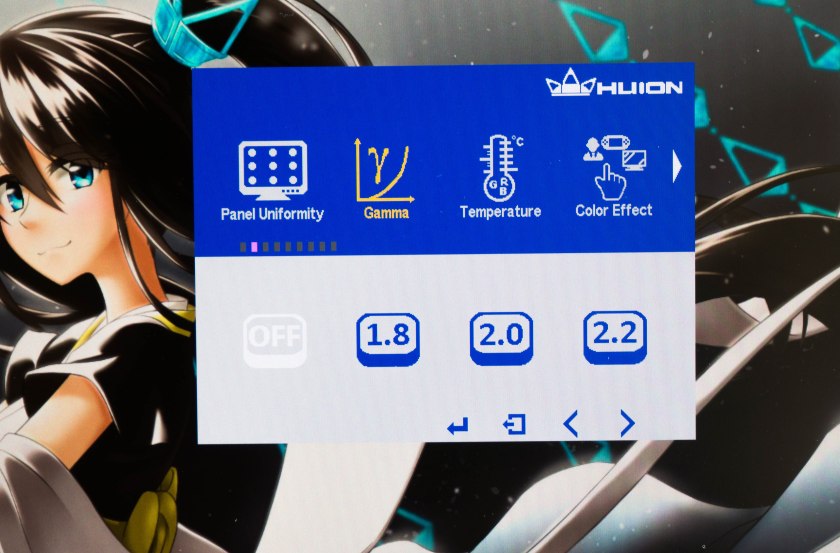
I mentioned above that the out-of-the-box colours are a bit strong on the blues, but you can actually fix this (for the most part) by changing 1 thing in the OSD settings. Just go to Color>Gamma and change it from Off to 2.2.
If you don’t like some changes you made in the settings, you can always return the settings to default by going to Other>Reset, so don’t feel afraid to mess around with the OSD settings to find the right colours for you.
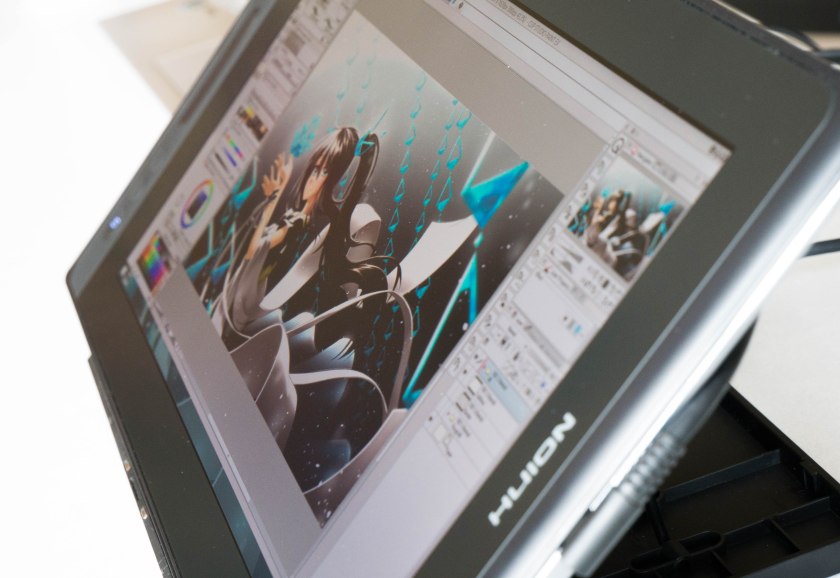
The IPS screen has pretty good viewing angles, but extreme angles are limited a slight bit by the texture which makes the colours seem a shade darker from extreme angles compared to when you look at it from directly in front. This is a non-issue though because you won’t be looking at it from any extreme angles while drawing. Overall, the IPS screen is very good.

One thing that Huion advertises about this tablet is its 120% sRGB color gamut. I have seen companies advertise 72% NTSC (roughly 100% sRGB) while failing to actually deliver that number, so I measured this while feeling skeptical. However, it turns out that Huion was serious about that number.
The above results from my calibration measured that the tablet has a volume of 127% sRGB, with my calibration profile set to cover 99% sRGB because I can only calibrate for use in the sRGB colour space using DisplayCAL. (The gamut volume is what the tablet is capable of, and the gamut coverage is what my color profile uses.)
This is a great result because this means that this tablet is suitable for use with colour accurate work. A drawing monitor without a decent screen is useless in my opinion, so the fact that the Huion Kamvas Pro 13 has a better than average screen (average among the competition being ~95% sRGB) is a very big plus.
Edit: Apparently the Huion JP account advertised a 92% AdobeRGB colour gamut which makes sense if you literally equate 100% sRGB with 76% AdobeRGB and cross multiply, but that is not how colour spaces work. It is important to note that increases over 100% sRGB can be improvements in colours that are not part of the AdobeRGB spectrum.
In the case of the Huion Kamvas Pro 13, around half of the extra 20% sRGB actually applies into the red spectrum of DCI P3 which isn’t part of the AdobeRGB colour space. This is why the AdobeRGB volume is measured to be lower than the expected 92%.
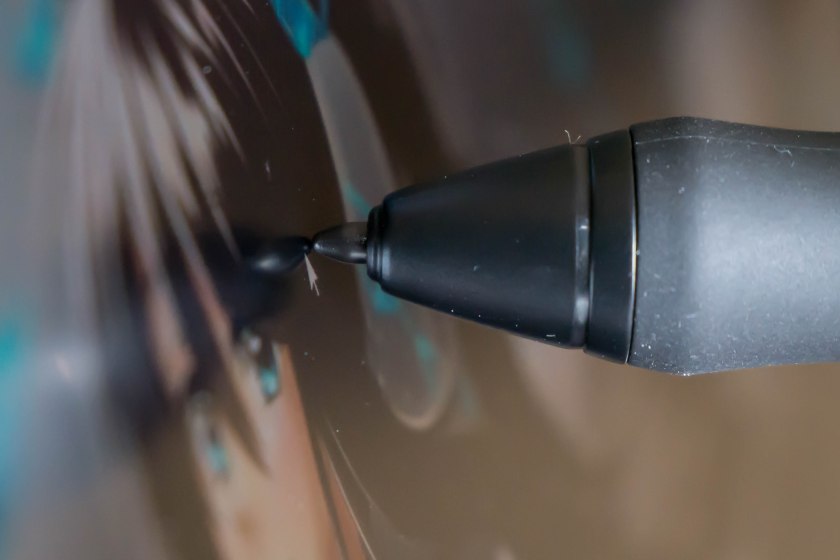
Another thing that Huion advertises about this tablet is that it has a fully laminated screen. This means that the screen and the surface of the glass have less of a visible gap, getting rid of the parallax you commonly see with glass panel drawing monitors.
As you can see in the picture above, the pen tip is quite close to the cursor, even when viewed from the side. For reference, the pen nib that you can see in the picture above is roughly 3mm from where it sticks out of the pen. This means that the distance between the pen nib and the cursor is actually only around 0.4mm!
Tablet drivers
The tablet drivers are extremely easy to install. You don’t even need to have your tablet plugged in to install them! Just go download the latest version from huion.com and remove all other tablet drivers you have on your computer before installing it.
Once you’ve installed the driver, the icon shows up in your taskbar, and the driver also creates a shortcut on your desktop so you don’t have to go searching for it in your apps.
Although the installer doesn’t prompt you to restart your computer after it finishes, I wholeheartedly suggesting restarting your computer anyways to allow Windows to properly update the files necessary for the driver to run smoothly.

In the driver, you can configure your tablet expresskeys, pen buttons, pen pressure curve, and work area.
There’s also an option to save different profiles manually using the import and export buttons in the “About” section.
Currently, the Huion drivers do not have a feature for automatically switching profiles based on your currently open application, so you can only change your profiles manually when switching between programs.
The Press Keys tab allows you to customize the functions mapped to your expresskeys. As you can see above, the hotkeys menu has keyboard shortcuts, pen clicks, and some “switch” functions available. The drop down menu for the keyboard shortcuts has every keyboard key that I can think of.
The only thing that I notice is missing is the double click function, but I guess it’s pretty easy to just double tap your pen instead so that can’t even be considered a problem. However, it would be a nice addition either way.Edit: Double-click has been added as an option to the Huion driver.
Like I mentioned before, the Huion shortcut keys do not have anti-ghosting capabilities. In other words, you cannot use two buttons at the same time. This will not matter in most cases, but you should keep this in mind if you think it affects you.
Every button will work at the same time as the pen nib though, including the pen buttons.
The touch bar is non-customizable, and according to the user manual it has 3 preset functions (brush size +/-, zoom in/out, and scroll up/down) which can be toggled using the bottom shortcut key.
I have suggested making the touch bar customizable to Huion though, so future driver updates may make the touch bar more flexible. However, I believe you should be buying this tablet expecting to use a keyboard for your shortcuts.
I personally need at least 8 shortcut keys to do my full drawing process on the tablet, so the 4 shortcut keys and 1 touch bar on the Huion Kamvas Pro 13 were not even close to enough for me. With this tablet, I opted to use my keyboard for all my shortcuts instead.
It is important to note that the ‘Enable Touch’ option is referring to the touchbar, not finger touch functions. This tablet does not have finger touch capabilities.

The Digital Pen tab allows you to customize the pen buttons and the pen pressure curve. The pen buttons have the same amount of configuration as the expresskeys.
Usually you will need to uncheck the “Enable Windows Ink” option to prevent Windows Ink from messing with your drawing. That said, some programs such as Photoshop usually do not work if it is not turned on, so play with that option as you see fit.
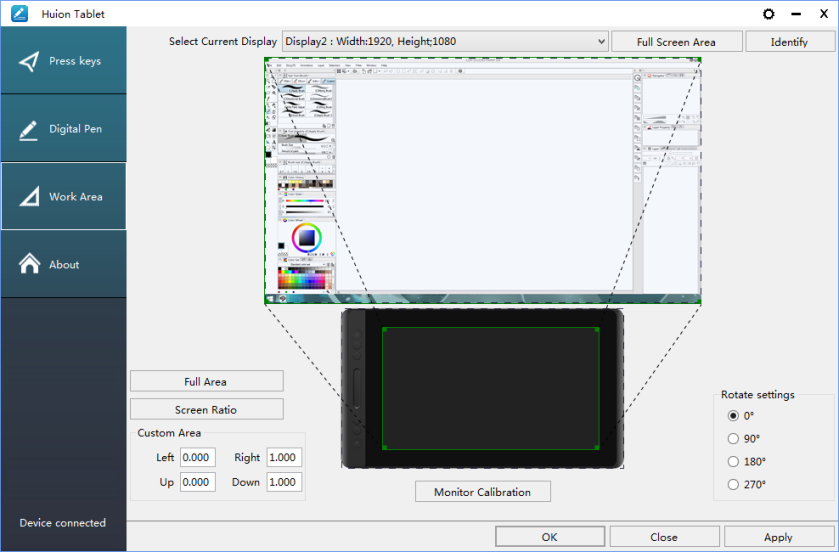
The Work Area tab allows you to customize the monitor your tablet is mapped to, the pen calibration, and the orientation of your pen inputs.
To use this tablet in left-handed mode, right-click on your desktop and select ‘Display settings’, then scroll down and change the Orientation to “landscape (flipped)’. Then go into the Huion driver and go to the Work Area tab, and select 180 degrees under the Rotate settings.
As a note for Windows 10 users, the default scaling in the Windows Display Settings is set to 150%, so you should go and change that to 100%. With Windows 8.1, the default was 100%. I’m not sure why Windows 10 defaults to 150%.
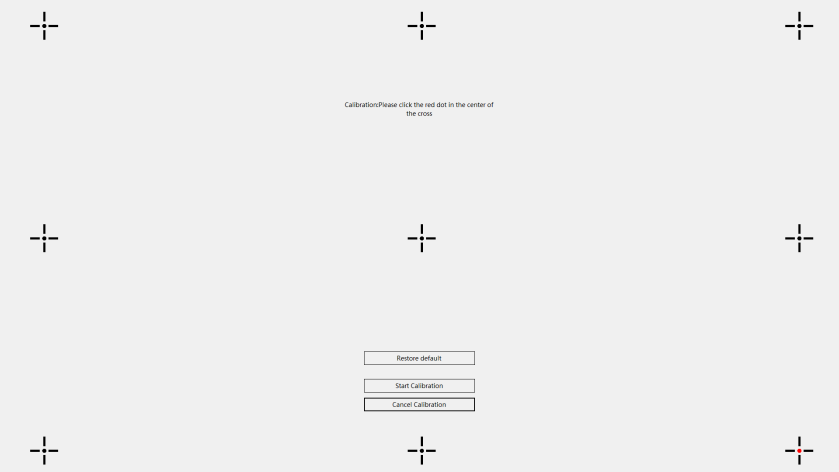
The monitor calibration for this tablet is a 9-point calibration. However, the default calibration is already pretty good with the fully-laminated display, so for the first while, I did not use the calibration tool.
However, later on I decided I wanted to use it and it was quite a pain because you had to do it once, figure out where it was off, then do it again while pressing slightly off of the dots to compensate, then rinse and repeat.
Basically, you can’t just press the dots in the middle and expect the calibration to be perfect. You have to test, then recalibrate based on the offset, then test again, and repeat until it’s correct.
Of course, once you do this and get it right, there are no problems. Make sure you save your profile after you do this, because you don’t want to lose all that calibrating work later.
Drawing tests
These pen tests are all done with the same settings for both the canvas and the pens. These tests are only done in Clip Studio Paint as that is the only program where I totally understand how to remove all unwanted variables.
If you are worried about whether this tablet will work with your art program, don’t be afraid to contact support to ask them directly.
-The canvas will always be a 3000x3000px 300dpi page (the above test page is a 3000x6000px 300dpi page, so just two pages stuck together).
-The test pens are mostly all 100px linear pressure curve pens. Pen pressure for size and/or opacity is enabled based on the test.
-The slow ruler line test uses a 10px no pen pressure pen to clearly show wobble and jitter. I also use a 50px pen pressure enabled pen to see the visibility of wobble/jitter with pen pressure is enabled.
-The IAF (Initial Activation Force) test uses a 300px linear pressure pen to show the thinnest lines possible, as well as demonstrate the IAF of the tablet.
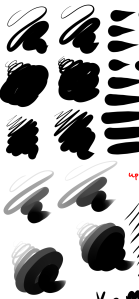
1) Scribble Test – Grade: Pass
Test pen 1 – 100px – pen pressure: size
Test pen 2 – 100px – pen pressure: size+opacity
For my pen tests, I always start out with a few pen pressure scribbles to see if I can do some nice squiggly lines with increasing pen pressure. I also do some back and forth shading and some spirals with increasing pen pressure.
With the Huion Kamvas Pro 13, I had no problems doing my little scribbles going from thin to thick. I didn’t have any problems controlling my strokes and making both thin and thick lines was relatively easy. This tablet gets an easy pass here.

2) Slow Ruler Line Test – Grade: Pass
Test pen 1 – 10px – pen pressure: none
Test pen 2 – 50px – pen pressure: size
The slow ruler line tests done with a no pen pressure pen were very good at all pen angles, even when holding the pen as far tilted as I could. You can see the tiniest bit of wobble in all of the pen angles tested, however, it’s such a small amount of wobble that we can safely ignore it.
This tablet gets a pass here.

3) Quick Hatching Test – Grade: Pass
Test pen 1 – 100px – pen pressure: size
The quick hatching test is to check whether the tablet keeps up with pen inputs. Usually, the only way to fail this section is if the pen is noticeably laggy and causes unwanted inputs like fishhooks at the beginning or end of the line.
As you can see, this tablet appears to have no problems with fishhooks. I also never noticed the cursor lagging so far behind the pen that it was a problem, so it gets a pass here.
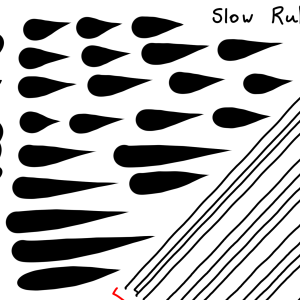
4) Short Release Taper Test – Grade: Pass
Test pen 1 – 100px – pen pressure: size
This test is meant to see the smoothness of the pen pressure taper when going from max to min pressure quickly. Basically, you press your pen down hard then flick to the side to see how smoothly the stroke tapers.
With the Huion Kamvas Pro 13, the tapers look very nice and appear to have no problems with jaggedness. This tablet gets an easy pass here.
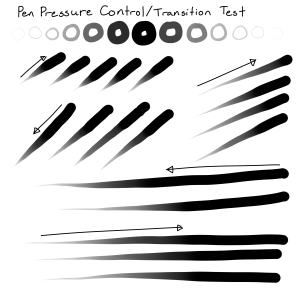
5) Pen Pressure Control/Transition Test – Grade: Pass
Test pen 1 – 100px – pen pressure: size+opacity
This section is to test the smoothness of the transitions in pen pressure.
-The circles at the top are one of Youtuber Brad Colbow’s tests. It is used to check if you can properly control the pen pressure all the way around a circle. If there is a pressure jump, some circles will feel impossible to control due to that jump.
-The lines at the bottom are slow strokes done with smooth increases or decreases to pen pressure in mind. The arrow points in the direction which the stroke was done, and the smoothness of the gradients show how smooth the pen pressure transitions.
In terms of the pen pressure control circles, I had no problems doing all the different circles smoothly. They showed no signs of pen pressure jumping.
I will give this tablet a pass here since there don’t appear to be any noticeable issues in the pen pressure transitions either.
6) Initial Activation Force & Lightest Pen Pressure Test – Grade: Pass
Test pen 1 – 300px – pen pressure: size
This test tries to demonstrate the IAF of the tablet, and also shows the lowest possible pen pressure the tablet is capable of producing consistently.
IAF is the amount of force necessary to cause the pen to output a line. Ideally, your tablet will have an extremely low IAF where the pen will output a line with the least amount of force possible.
A high IAF causes issues such as light pen taps not registering as clicks, and the inability to sketch very lightly, both of which become quite annoying the more you experience it.
For this test page, the squiggly lines should begin right on the start line.
-If the line begins right on the start line, this indicates that the IAF is extremely low (low IAF is best) and the line just appears naturally without effort.
-On the other hand, if the line does not begin on the start line and instead begins further along the stroke, this means that the IAF is high so I needed to search for the IAF by increasing my force little by little until I finally started outputting a line.
An example of the ideal test page is the Huion New 1060 Plus (2048) IAF test page which I included above for comparison. Almost all the lines begin right on the start line meaning it has extremely low IAF, and the lines are almost transparent showing that the tablet is capable of drawing extremely light pen pressures.
The Huion Kamvas Pro 13 has a fairly low IAF which I could find almost right away. As you can see, I was not able to get the lines to start on the start line, but I was able to start them right beside it.
Basically, the IAF is low enough that I don’t consider it an issue. I never noticed it when tapping options or sketching lightly.
In terms of the lightest pen pressure, I could get really thin lines with the 300px IAF test pen. The thin lines on this tablet are not quite as amazingly thin as the Huion New 1060 Plus (2048) IAF test page which is the ideal, but this thinness is extremely good and is more than acceptable.
Overall, the Huion Kamvas Pro 13 has fairly low IAF and is able to draw very thin lines consistently. This tablet gets a pass here.
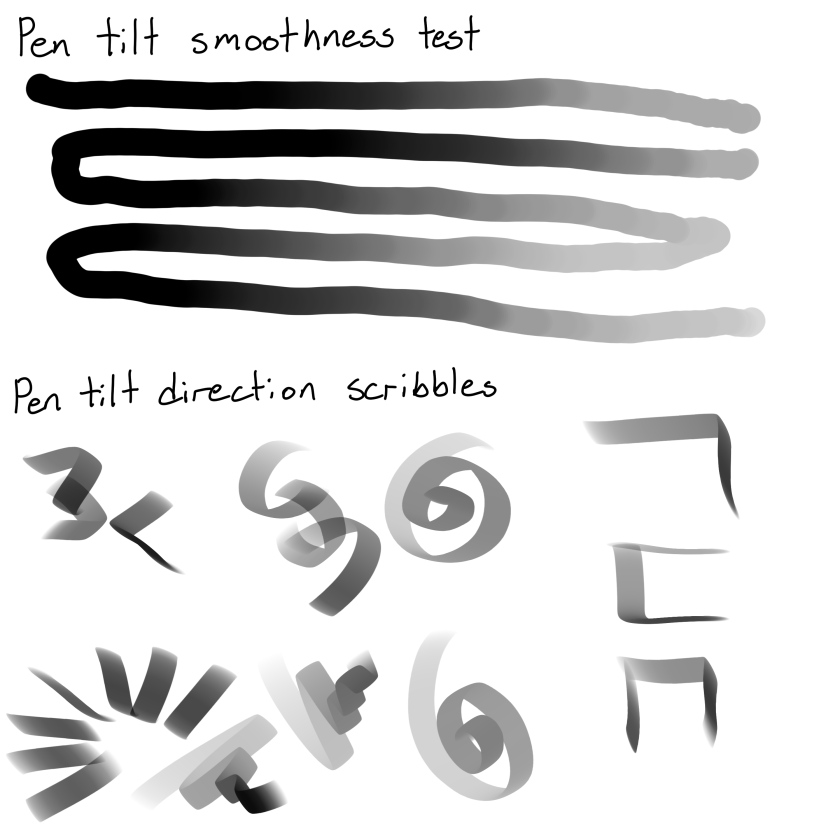
7) Pen Tilt Test – Pass
Test pen 1 – 100px – pen tilt: opacity
Test pen 2 – 100px – flat pen – pen tilt: direction
This test shows the smoothness of the pen tilt by gradually tilting the pen while slowly moving the pen to the side. This section also includes scribbles using the pen direction determined by pen tilt.
As you can see in the smoothness test, the pen tilt transitions on the Huion Kamvas Pro 13 are not perfectly smooth. You can certainly see the steps in the gradient, but that’s expected with only +-60 levels of pen tilt.
With that said, if you go look at my recent Wacom Intuos Pro 2017 review, you can see that the pen tilt on the Huion Kamvas Pro 13 is very competitive in smoothness to the pen tilt of the supposed “industry standard” tablet brand.
This tablet gets a pass here for sure.
Overall
So all in all, the drawing test results are:
1) Scribble Test – Pass
2) Slow Ruler Line Test – Pass
3) Quick Hatching Test – Pass
4) Short Release Taper Test – Pass
5) Pen Pressure Control/Transition Test – Pass
6) Initial Activation Force & Lightest Pen Pressure Test – Pass
Non-Vital Drawing Tests:
7) Pen Tilt Test – Pass
Ideally, all the above tests should have at least a “Pass-ish” for their grades because the most vital function of a drawing tablet is to draw properly and predictably. Failing any of these tests means that it doesn’t do that.
The drawing experience!
The drawing experience on the Huion Kamvas Pro 13 was really pleasant. I did have to play with the pen calibration for a while to get it right, but the pen experience was really nice after that.
The surface of the Huion Kamvas Pro 13 is quite smooth, but it does have enough texture to make it feel much more enjoyable than pure smooth glass. The pen is also quite nice and is very comfortable to use for long periods of time.
Due to the texture being fairly smooth, your nib basically never wears, and I doubt there is very much risk of wear out your screen even if you don’t have a screen protector.
Another thing I noticed is that the pen nib “creaks” slightly when using the pen tilted very far over. This means that the pen nib is not sliding smoothly against the side of the pen when the pen nib is pressed against the side.
However, with that said, I did not notice it affecting the smoothness of the line, and it does not happen unless the pen is held at a very tilted angle.
The temperature on the tablet stayed quite consistently cool despite drawing on it for hours on end. The only part that gets warm is the top middle part above the screen where it shouldn’t affect anyone, even left-handed people.
I noticed that the pen calibration is a bit off on the edges of the screen, but only very close to the edges. The calibration is pretty good everywhere else.
I wish Huion had included a drawing glove like they usually do for their other drawing monitors since I know I would need it to prevent myself from fouling up the screen really quickly. I already have some drawing gloves so I used those instead, but including a drawing glove for people who don’t already have them would have been a nice addition.Edit: It appears they include a drawing glove for some orders, like the Amazon.com page which advertises a free drawing glove as a gift. However, if it isn’t listed in the “what comes with the product” list like on huiontablet.com, then I believe it won’t come with one.
Update (Dec. 5, 2018): As you may have already heard, the Huion Kamvas Pro 13 has been plagued with complaints about line wobble. Many people didn’t have this issue, but just as many did, so it was a big deal to not know whether you would get a good or bad unit.
However, as of last night, Huion sent me their firmware update for fixing the line wobble and it has actually straightened out the slow lines on my unit substantially. If this applies to all the units with wobbly lines, then this means that there is no longer any fear of getting a “lemon” when purchasing the Kamvas Pro 13.
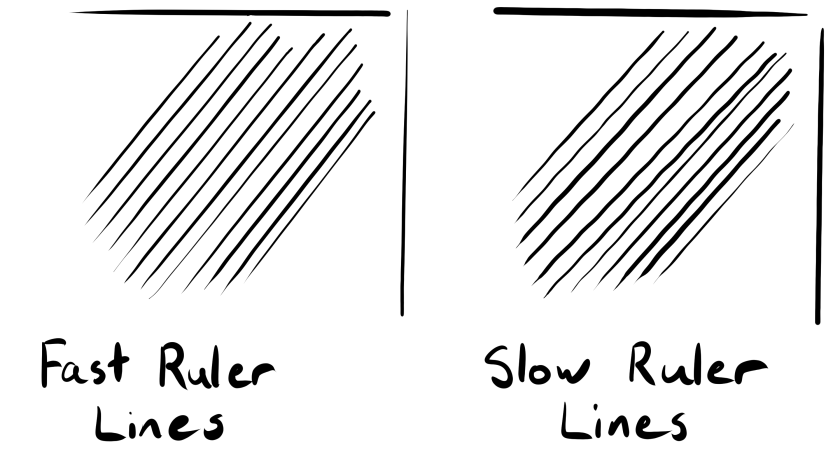
I demonstrate the speed at which you have to draw for wobble to show up in this unlisted Youtube video: https://youtu.be/k0_LCBtjAJE
The above test page and video were done before the line wobble fix. I made them to show what speed you needed to draw these lines to check whether your tablet had bad line wobble or not. As you can see in the slow ruler lines section, the lines used to wobble quite a bit.
The above image is the line wobble test after the December 5th firmware update. As you can see, there is basically no wobble. Any line wobble that’s still there is completely negligible and basically not there at all, even when drawing at slower speeds.
So as you can see, for my unit specifically the line wobble has been corrected by the firmware update.
Of course, I am yet to confirm with anyone else that the firmware update has corrected their line wobble, but for my unit specifically, the firmware update fixed it.
Edit: It appears CreateNowSleepLater on Youtube has also tested the firmware update and confirmed that it corrects the previous line wobble.
For those of you who already own a Kamvas Pro 13, or receive a new one after this date, you can check your Firmware Version by going into your Huion driver, then going to the ‘About’ tab, and clicking the keyboard keys Ctrl+V+E+R, all at the same time.
The firmware version which fixed the wobbly line issue is HUION_M182_181206. If you have a previous version and notice that your lines are quite wobbly, you should contact Huion at service@Huion.com to get the firmware update and instructions on how to update your device.
Conclusion
I recommend this tablet to anyone interested in it. It has a fantastic screen with great colours and basically no parallax, a comfortable battery-free pen with pen tilt functionality, and a slim profile which makes it easy to take from one workplace to another.
Other 13-inch Wacom alternative tablets actually do come a bit cheaper at ~360 USD (tablet stand price included) compared to the Huion Kamvas Pro 13’s 400 USD price. However, I believe the Huion Kamvas Pro 13 completely justifies its higher price with its quality and features.
A very good thing to note here is that the Huion Kamvas Pro 13 is currently the only Cintiq alternative which has a fully-laminated display with no parallax, just like the Wacom Cintiq Pro. This means that you’re actually getting the tablet capabilities of 1000+ USD tablets in a 400 USD tablet.
If you’re looking for a good drawing monitor, I think the Huion Kamvas Pro 13 is a very compelling option.
Places to buy the tablet
Huion Store | Amazon.com | Amazon.ca | AliExpress
People living in other regions should check their regions Amazon or see if the Huion Store ships to them.
If you have any questions about the tablet, feel free to ask me!























Found this on reddit. Thanks for all the information.
Also have to give it up to you for keeping your display monitor alternatives so well updated. Didn’t realize XP-pen released a 12 inch model! It looks really promising. Have you had the chance to try it out or plan on trying it?
LikeLike
Hey there, thanks for visiting!
I try to update it whenever I notice a new product. As a small tip, you can actually stay relatively up to date with most of the new products if you follow the tablet companies on Facebook!
With regards to the XP-Pen Artist12, I would really like to try it because it’s such a cheap option and would be a great “starter” drawing monitor if it works to spec (the fact that it costs less than Wacom Intuos Pro is really appealing).
Unfortunately, I have no plans to be buying new tablets in the near future, so I don’t think I will be reviewing it. I’m going to try to contact XP-Pen to see if they’re interested in sending me one for review, but I’ve never been successful in getting a review tablet from XP-Pen, so the chances are slim. They do send out quite a few review tablets to Youtubers, so you can keep an eye out for those though.
-Nikage
LikeLike
Thanks for a great review, you convinced me to buy one.
What are the touch bar functions? Is it responsive? I really enjoy the touch wheel on by old wacom and I’d love to have a substitution for it.
By the way, you can buy one for ~$340 on aliexpress next week with free shipping (for us non-Americans :), glove included!
LikeLike
No problem, thanks for reading!
The touch bar preset functions according to the manual are Brush Size+/-, Zoom In/Out, and Scroll Up/Down. The touch bar is responsive, but it isn’t customizable like the Wacom touch wheel is.
I did suggest making it customizable to Huion, so it may change with future driver updates, but at the moment I think the touch bar is completely inferior to Wacom’s touch ring because it isn’t customizable. It’s useless right now in my opinion.
Ah thanks for letting me know. AliExpress keeps slipping my mind for some reason so I haven’t checked it yet.
-Nikage
LikeLike
Awesome right up. Here is some video on it: https://youtu.be/Cn5dBEyYEE8
LikeLike
Hello! Thanks for the helpful review, I preordered it when a big sale was going on at the time, so I was able to get it cheap thankfully. Now, referring to the wobbling issue, would this be an issue still if the CSP’s stabilizers are in affect from this? I wasn’t sure if it reduces it or doesn’t do any help at all, also my tablet is arriving tomorrow by the time I’m writing this so I can update if my experience with the wobbling is annoying or not. Anyway, thanks for reading and I hope your day goes great for ya ^^
LikeLike
Hey there,
No problem, and thanks for reading!
For the wobble test which I added after watching Brad Colbow’s review, I turned off all the stabilizer settings that I could find. However, having no stabilizers active gives the same result as when I had a small amount of stabilizer on because doing slow lines “ignores” stabilizers.
I would be very interested in hearing about your experience with the wobble. I personally think it is something that all the Huion Kamvas Pro 13’s have, but there have been quite a few reviewers claiming that theirs do not have any wobble. My belief is that they are just doing the wobble test too fast compared to Brad Colbow and I, but I really can’t tell yet with how few people have the tablet so far so your input would also be helpful.
The video I linked of fast vs slow diagonal lines should help you figure out the speed Brad Colbow and I test at. I believe the reviewers who claim they have no wobble just test at the “fast” speed or faster since, as you can see, testing just that slight bit faster makes the wobble completely disappear.
Edit: Brad Colbow uploaded an update video to show how fast he tests at as well to see wobble, so you can refer to that too: https://www.youtube.com/watch?v=tsPHG4VN5qQ
-Nikage
LikeLike
Okay, got it today and so far the wobbling is there but not as much, it maybe because of Clip making it lesser so. The only thing I’m having a hard time with is getting use of implying clicks with a little pressure, I dunno if there’s something in the tablet I might have miss to make it so. Otherwise, the tablet is pretty good for the most part!
LikeLike
Okay, I got the tablet and so far I can sorta see the wobbling happening when I draw slow to normal strokes like you’ve mentioned. I’m hoping Huion is aware and fix the wobbling soon enough because it can be a little distracting for me ^^;
LikeLike
Hey, thanks for letting me know! I hope they’ll be able to fix these issues too. Wacom fixed their wobbly line issue with a pen firmware update, so I’m pretty sure Huion will be able to do the same as well.
LikeLike
Just a hunch as I don’t have this tablet yet–can it be that the tablet is so sensitive it is picking up minute muscle quaver in the user’s hand? So that a quick stroke is finished before the quaver is recognized, but the slow stroke picks it up. I know the same thing happens to me with a real pen. This could actually be tested by a physiologist. Thanks for the careful review!
LikeLike
Hey there,
I don’t think that is the issue. This is because the waves in the wiggly lines are the exact same distance for every single slow stroke.
If we were to assume that it is picking up muscle shaking, then that means I was shaking at the exact same spots, the exact same amount in the exact same direction, at the exact same distances. I do not believe that can happen consistently.
I believe the wiggly lines in this case are caused by quality control issues during production based on the fact that there are also many people who have Huion Kamvas Pro 13’s without the wiggly line issue, and just as many who have it as well.
Thanks for checking out my review!
Nikage
LikeLike
Hey! It’s me again. the experience is pretty good despite the wobbling lines problem but I do want to ask one thing about the screen, does the screen still hasn’t show a scratch still after this review was published? You see, i haven’t took the mask off out of it yet since I don’t have a glove for it to make it easy on drawing. I’ve noticed the amount of scratches on the screen with the mask on, again not on the actual screen itself. It might been the heavy pressure I tend to apply on the screen, I have no clue but I want to be sure if it doesn’t do the same effects on the actual screen itself. Does yours on the actual screen affected by this by intensive pressure or no? Sorry for a ton of questions recently, it’s my first ever screen tablet and I want to have it worth my while, thanks for reading and goodnight!
LikeLike
Hey, don’t worry about asking questions, I’ll answer whatever I can.
As far as I can see, I don’t see any scratching or wearing on my screen ever since I started drawing on it. I have also done a fair bit of heavy pressing while colouring so I don’t think pressing hard will cause it to scratch either, at least based on my experience.
Honestly, I can’t guarantee you anything about how long it’ll take before it shows wearing, but I don’t think it’s something you will need to worry about. I just suggest that you make sure to not drop knives or scissors on the screen since you don’t want to leave actual dents or cuts in the glass.
-Nikage
LikeLike
Hi there! Great review… thanks for putting this together. I am very interested in this device. I can’t find anywhere about how long the cable actually is. If you have a spare moment it would be much appreciated if you could let me know. Kind regards, Dean.
LikeLike
Hey there,
Thanks for asking.
The cable is a combined cable, so I’ll try to describe it based on the length of the cables from the 3-way split.
The cable is ~142cm from the USB type-C to the 3-way split, then ~37cm from the 3-way split to the USB type-A and HDMI. The length of the power cable from the 3-way split is ~193cm.
Edit: Here is a really rough diagram of what I described above: https://digitalarttabletguides.files.wordpress.com/2018/08/cable-lengths.png?w=300&h=300
I hope that makes sense,
Nikage
LikeLike
Perfect – thanks for taking the time to answer my question 🙂 Nice diagram too!
LikeLike
Hey, it’s me again and I encountered something later on today and wonder if this is a problem with my tablet alone or anyone else’s. When I’d leave the screen on screen saver mode, I noticed light areas on the corners and at first I thought this is normal until I searched about it and realized being a common problem for LCD screens. I don’t know much about screen tablets due for the fact this is my first owning of one, I contacted Huion to see a response but I want to be sure if it’s just a overreaction from my part. I’m curious if this is a same problem with yours, if not then it might be faulty but who knows. Thanks for reading and have a good day!
LikeLike
Hey again,
That phenomenon is called ‘backlight bleed’ and as you said, it is a fairly common occurrence in LCD monitors. It also occurs in small patches on my Huion Kamvas Pro 13 around ~1mm along the right and left edges, with the worse spot being the bottom right corner with a rough area of ~2mm.
I believe it is completely normal to get at least some backlight bleeding and it only affects color accuracy in the spots where it’s located. In my case, the backlight bleed is not occurring in a place I would ever draw on, so it is not a problem whatsoever.
However! It is a problem if your backlight bleeding is not limited to small areas along the edges and looks more like this: https://imgur.com/gallery/ZcJlq
If it is extremely clear that your backlight is bleeding excessively, then you have a faulty unit and should look to get it replaced immediately. But otherwise, it is usually expected that there will be some small backlight bleeding along the edges.
-Nikage
LikeLike
Hey Nikage,
about 2 two weeks ago I bought my first Drawing Monitor, the Huion Kamvas Pro 13. So far I’m happy with it, but today noticed some backlight bleeding that wasn’t there before. I’m pretty sure that my Kamvas Pro 13 had almost no backlight bleeding when I first used it, but now this bright spot suddenly appeared at the bottom: https://imgur.com/a/NCmDxqU It doesn’t really hinder my drawing process and I don’t notice much color difference overall. But it still kind of annoys me. 😦 I’ve read that backlight bleeding is a fairly common in LCD monitors, but could you tell me if this amount of backlight bleeding on my Kamvas Pro 13 is still normal or should I get it replaced? Thanks for reading!
LikeLike
Hey there,
I took a look at your photo and I believe your backlight bleed (especially the bright spot in the middle of the bottom edge) is a bad enough case of backlight bleed that you should try to get it replaced if possible. My unit has backlight bleed in the corners, but the bleeding is not as big or as bright as yours.
I’m pretty certain that excessive backlight bleeding is a defect, so it should be covered by the warranty (I would argue the shipping should be covered as well).
Anyways, I suggest sending Huion a message and see what they have to say.
Sorry for the troubles,
Nikage
LikeLike
Ok, thank you for taking your time to answer my question!
LikeLike
Witch you can recommend just now., The Huion Kamvas Pro 13, or the XP-Pen Artist 12?
LikeLike
I can recommend both, but I think you should avoid the Huion Kamvas Pro 13 if you know the wobbly lines will get in the way of your art style (ex. you know you do slow strokes for inking, etc).
LikeLike
I have a macbook air which doesn’t have an HDMI input, is there any kind of adaptor I can use to connect the Kamvas Pro 13 display to my computer?
LikeLike
I’m not completely sure about Macbooks, but I believe any HDMI adapter to whatever monitor port you have will work. You can learn about that by Googling “how to connect an external monitor to my Macbook Air” I believe.
LikeLike
Nice! Thanks for the updates!! I check for your update almost daily. Hope the new firmware fix the problems with the wobbly lines so i can get my unit.
LikeLike
I really hope it fixes it too!
LikeLike
Nikage, have you tried the new firmware fix yet for the wobbly lines? I am *that close* to pulling the trigger, and would like to know for sure before I do. Thanks for the ton of work you put in on this page. I’m a photographer and would be using it for photo editing.
LikeLike
Hi there,
I just received the firmware update last night and finished testing it this morning. The firmware update which I received has completely fixed the wobbly lines as far as I can see.
I have updated my review, and you can see how much better the lines now are in the The Drawing Experience! section of my review.
Thanks for checking out my blog,
Nikage
LikeLike
Heya! If this isn’t too much of a trouble, will you make a list of Huion models (or even from XP-Pen and Parblo’s, if you want) available out there, maybe with a little summary on what’s the differences between each tablets and it’s main feature/selling point? I’ve been interested in Huion tablets lately, but I can’t seem to find a place that summarize each tablet’s difference/features, nor the ones that are considered good or bad, old or new. This list could be great for those who wants to research more about Wacom alternatives, but overwhelmed by the amount of models available out there. Just a suggestion, though! You don’t really feel obligated to do one. Thanks in advance! Love your reviews, btw 🙂
LikeLike
Hey there,
That is a pretty good idea!
Thinking about it now, it’s true that my masterlists of tablets only really help to see what’s available, and not what’s “best”. I certainly understand the feeling that Huion has too many tablet models (and lots of similar ones at that), so I might consider trying to group them and try making sense of them.
Thanks for the idea, I’ll consider it for sure.
Thanks for checking out my blog,
Nikage
LikeLike
Awesome! Now that the wobbly lines are gone i will get my unit. Thanks for the reviews and the update Nikage!!
LikeLike
Hello, I have had this tablet for quite a while but have experienced one problem with it that I have been emailing their customer service about for MONTHS, ever since I got it around August. My pen lags, almost as if it was an ink pen running out of ink- I have to scribble to get it to work. It is the same on every drawing program I try- FireAlpaca, Krita, MediBang Paint Pro. The only thing it does work on is Microsoft Paint, which I despise using.
I was wondering if anyone else had this problem that you know of, or if its similar to the pen wobbling thing you mentioned.
LikeLike
Hey there,
I’m not completely sure what issue you’re talking about based on the word description you’ve given me. Perhaps you could take a video showing the issue and uploading it as an unlisted video to Youtube so you can show people what the issue you have is more accurately.
Unfortunately, your pen lag problems most likely have no relation to the pen wobble.
If I were to take a completely random guess, did you make sure to uninstall any previous tablet drivers which were on your computer (for example, previous Wacom drivers) before installing your Huion drivers? Having more than one tablet driver on your computer causes conflicts and often causes tablets to not work properly.
Another guess is to try disabling Windows Ink in the Huion drivers. Go into the Huion settings, then go to the “Digital Pen” section, and uncheck the “Enable Windows Ink” checkbox. Windows Ink has functions which impede drawing, so it’s usually best to turn it off. However, some programs like Photoshop will not work without Windows Ink enabled, so enable/disable that setting accordingly.
Anyways, if you could take a video of the issue to better show the problem, please do so! It could also help Huion support to better pinpoint the problem as well.
-Nikage
LikeLike
Hi, could you please tell me the colour settings for your tablet? Because somehow my reds are looking really pinkish and I tried to play around with the RGB settings but I’m having a really hard time to even get the colours close to my laptop. Also, the screen on the tablet isn’t full size although it says it is in the settings. Is this because of the screen size of my laptop? (It’s a Lenovo thinkpad) Thank you!
LikeLike
Hey there,
The colour settings that I have in the OSD settings are R=119, G=114, B=106 with Backlight=45, Brightness=50, Contrast=62, Gamma=Off.
Please note, the Kamvas Pro 13 is capable of showing reds which many “average” monitors cannot. Seeing a very slight red tint does not mean the Kamvas Pro 13 is wrong. It just means that the other monitor was not capable of showing those reds.
Note that no two screens are made exactly the same and screen colours also drift slightly over time, so my settings may not give you optimal results.
You should also try eyeballing the correct colours using the Windows Color Calibration tool, or a site like http://www.lagom.nl/lcd-test/. You could also consider renting a colorimeter from an electronics store which offers that.
Hope that helps,
Nikage
LikeLike
Hi I was wondering if you know the solution to my problem regarding the display of my Kamvas pro 13. The display is not viewing full screen in the tablet. I tried changing the display options from the laptop itself but it didnt work for me.
LikeLike
Hi there,
Could you perhaps elaborate a bit more on the problem, and maybe supply some photos or screenshots? I can’t tell what the issue might be from your current description.
You may also want to contact Huion support for help since I am not completely confident in my ability to troubleshoot problems (although they are away on weekends so you will have to wait until Monday for a reply).
-Nikage
LikeLike
Hello! Thank you for your review, I recently decided to purchase this after reading your thoughts on this model. I’m still trying to adjust from my old tablet, but apart from some annoying gimmicks (e.g. the pen occasionally treated the side buttons being pressed as the pen’s tip is touching the surface as well, causing small dots to appear by accident while I draw), I’m confident I’ll get used to it.
If I may ask since you also use Clip Studio Paint…this may not be related to the tablet itself, but I noticed that when I put this monitor in extend mode as secondary monitor, application always freezes when I add 3D model to the canvas. This only happens when the CSP window is in the tablet/secondary monitor, but not when the tablet is set as primary monitor or using other modes.
I suspect it has something to do with the graphics card since I noticed the laptop monitor uses the Intel integrated graphics driver while the tablet uses the NVIDIA graphics card, but I am not certain on why. Have you ever encountered this kind of problem when using the tablet?
Thank you!
LikeLike
Hi there,
I’m glad to hear that your experience has been mostly positive with your new tablet.
With regards to CSP freezing when adding a 3D model, I have not run into that problem as I do not use 3D models. However, even when I tested adding 3D models on extend display mode, CSP on my desktop computer does not freeze.
I also tested this on my Laptop with Intel iGPU and Nvidia GPU since that seemed like a similar laptop to yours (although it’s Windows 8.1, not Windows 10). I set up my laptop and Huion Kamvas Pro 13 to extended mode with the Kamvas Pro 13 being the secondary monitor, not the main one. Then I opened CSP on my Kamvas Pro 13 and tried opening a 3D model, but my CSP does not freeze.
Just to make sure, but did you uninstall your previous tablet’s drivers and restart your computer before installing the Huion drivers? Multiple tablet drivers on the same computer mess each other up which is why tablet companies always stress that you need to remove all previous tablet drivers before installing new ones.
If you did uninstall your previous tablets drivers properly, did you also try changing the “Preferred Graphics Processor” setting in the Nvidia Control Panel?
From NVIDIA Control Panel
3D Settings->Manage 3D Settings
Tab “Global settings”
Preferred Graphics Processor
Select : High performance NVIDIA processor
Have you also tried letting CSP just run its course when it freezes to see if it unfreezes by itself after, say, 5 minutes? If it’s using the iGPU instead of the discrete GPU, it may be that the iGPU is struggling and taking a while to render the 3D model just like how CSP struggles and looks like it froze when rendering and saving a large PNG file.
That’s all I can think of in terms of “general” fixes. If those do not work, I suggest contacting Huion support as they will most likely know more on how to fix problems on their tablet than I do. Unfortunately, they are away on the weekends, so you will have to wait til Monday for a reply if you contact them.
I hope you can find a solution to your issue,
Nikage
LikeLike
Hello! Thank you for your detailed reply, and sorry for the lateness from my end.
If it’s okay, what versions of CSP and the NVIDIA driver that you use?
After doing some testing on my TV as second extended monitor as well as messing around in the seetings, it looks like the problem is not in the Huion tablet itself; rather, it seems to be either in the CSP or the NVIDIA driver. This is because when I use other 3D-oriented programs such as Blender and Unity they run just fine so far. Meanwhile, I tried to drag the 3D model in the TV as secondary monitor and it crashed all the same.
I tried searching in CSP forum and it seemed that another user encountered similar problem when using recent version, though they use Cintiq instead. No fix so far apart from using the tablet in duplicate/primary display mode, unfortunately, but at least it is good to know the problem is not in the tablet itself.
LikeLike
Hey again,
My Windows 8.1 laptop runs Nvidia driver version 391.35 with a Nvidia Geforce GT 620M (this was the latest version available when I looked at the Nvidia downloads for my GPU).
On the other hand, the CSP version was 1.7.8 which was not the most current CSP available (the current version is 1.8.5). So I updated it to version 1.8.5 to see if it would crash with that, but 3D models did not crash even with the newer version.
Edit: Also, my Windows 10 desktop uses an AMD GPU with CSP version 1.8.5 so it’s kind of hard to use it as a reference since it’s so different from your device, but 3D models do not crash on it.
Perhaps you should try a full reinstall of CSP if you haven’t already.
I’m not sure if that info helps, but I hope it does,
Nikage
LikeLike
Hi Nikage.
I currently looking for a relatively cheap graphic tablet to upgrade from my Wacom Intuos small and find this Kamvas and XP-Pen Artist 12 a potential buy. I’ve read through your review of Artist 12 seeing the tablet comes with a HDMI connector adapter. Does Huion Kamvas come with this kind of adapter? Since I am a Mac user and buying a new adapter is an *cough* expensive issue.
Regardless of the price, which one is better in the term of portability?
Looking forward to your response, thank you!
Iqbal
LikeLike
Hey there,
Unfortunately, the Huion Kamvas Pro 13 does not include the HDMI to DisplayPort adapter which comes with the XP-Pen Artist 12. I certainly understand the *cough* expensive issue of adapters for a Mac haha.
Anyways, ignoring price, I believe the XP-Pen Artist 12 is technically the more portable option due to one feature: It can run solely off USB power and does not need to be connected to a separate power outlet. This means that all you need is your laptop/desktop to use the XP-Pen Artist 12, and you don’t need a wall outlet.
On the other hand, the Huion Kamvas Pro 13 requires that you connect it to a power outlet to turn on, so if you have no access to a power outlet, you will not be able to use the tablet.
Aside from that difference in USB power vs wall outlet power, both tablets are very slim and portable and should be very easy to carry around. You may also want to keep in mind that the XP-Pen Artist 12 will not come with a tablet stand, whereas the Huion Kamvas Pro 13 will.
Ultimately, I think the choice relies on whether you intend to work in places with or without power outlets.
In my opinion, I have found that the Huion Kamvas Pro 13 has better colour reproduction than the XP-Pen Artist 12, so if you know you will always be working in places that have available power outlets nearby, I would recommend the Huion Kamvas Pro 13 for it’s capabilities (although you will have to buy an adapter since it won’t come with the tablet).
I personally would not trade the colour accuracy for the portability, but that’s just me, and you should decide what’s most important to your situation, and whether the extra price is worth it for you.
I hope that helps,
Nikage
LikeLike
Hi Nikage,
Thank you for taking time replying my message. Choosing between Kamvas 13 and Artist 12 surely is hard for me. I do agree with the colour reproduction on the display should be a main consideration for a graphic tablet, while other things as portability and additional adapter taking my minds. I think I will go for Kamvas and spend *cough* more on the adapter.
Thank you! Looking forward to another reviews from you.
Cheers,
Iqbal
LikeLike
Hi again,
Have you noticed that the Huion 13 is calibrated not from the tip, but a couple millimeters ‘upwards’ or into the pen? Its starting to get pretty distracting, and unpredictable because of how much it changes when you hold the pen in a slightly different angle. I don’t know if it can be fixed through software updates or if it is a hardware limitation, depending on the placement of the sensor.
This is particularly distracting because I hold my pen in a very weird angle- tilting downwards. It’s different in different areas of the screen.
How do you handle this issue?
In fact, this is the only issue I have (left, the wobbling and the calibration uneven-ness was fixed) with the K13. Its a pretty fantastic tablet otherwise.
Then again, if the primary function of a drawing monitor is not executed well, what’s the point of having one?
Regards
LikeLike
Hey there,
Yes, I have noticed that the Huion Kamvas Pro 13 does not properly take pen tilt and direction into account when calculating cursor position relative to the pen nib.
Personally, I have never had a problem with this as I always hold my pen at almost the exact same angle when drawing, and I zoom or rotate the canvas to get the right angle for my stroke rather than change my grip or the direction of my arm. Unfortunately, this caused me to perceive calibration as unimportant in the past because I was unaffected by it (since the cursor would always be directly under my pen nib after calibrating it).
However, I have since then realized that calibration should be expected to be better than that, so I have been pushing Huion and XP-Pen to use pen tilt and direction in their pen calibration.
Sadly, only Huion has implemented the calibration technique of using pen tilt and direction so far on the Kamvas Pro 16 (and it’s not perfect yet), and I haven’t heard of any plans for them to introduce this calibration method to the Kamvas Pro 13.
As far as I know, this is a driver/firmware thing as the Huion Kamvas Pro 13 pen is pen tilt capable, so theoretically they should be able to use that information to recalculate the cursor position properly.
If you hold your pen in that same weird angle all the time, then as a stopgap fix, I believe doing the pen calibration in the drivers while holding the pen how you always hold it should put the cursor nearer to where you expect it to be. If you repeat this enough times while adjusting where you click the red dots to compensate for the error, you should be able to get the cursor directly under the nib where you want it to be. It will take a fair bit of time to get it exactly how you want it to be, but it’s worth trying.
However, if you hold your pen in multiple different ways and directions, then this will most likely not fix your issues as this can only set the cursor position properly for one pen angle.
It may also be worth it trying to draw while depending on zoom and rotate instead of changing your arm angle to get the right stroke.
Pen calibration is the one aspect where Wacom is indisputably much better than Huion and XP-Pen at the moment. Their newer drawing monitors all use pen tilt and direction to recalculate the cursor position properly so that it is always direction under the pen nib no matter what angle you hold the pen at.
I am unfortunately still severely lacking in my experience with drawing monitors (because I don’t get my hands on very many), so I appreciate it very much that you brought up this issue. I will need to re-evaluate my testing criteria with regards to drawing monitors as it appears I have not put enough emphasis on pen calibration.
Again, thank you very much for bringing up this topic to me. I will try my best to convince Huion and XP-Pen to work on including pen tilt and direction in their future pen calibrations.
-Nikage
LikeLike
Hey Nikge,
In the comment I’m replying to you said “Huion has implemented the calibration technique of using pen tilt and direction so far on the Kamvas Pro 16 (and it’s not perfect yet), and I haven’t heard of any plans for them to introduce this calibration method to the Kamvas Pro 13.”
Is this still the case even now? or have Huion implemented this technique in the pro 13 some time after you wrote this comment?
LikeLike
Hey there,
I checked just now with the latest firmware and drivers, and yes, the Huion Kamvas Pro 13 appears to now have the same pen calibration as the Huion Kamvas Pro 16 which takes into account pen tilt!
(Although it should be noted that, just like the Huion Kamvas Pro 16, the pen calibration is still not as good as Wacom’s pen calibration using pen tilt. It appears there were no improvements made to the accuracy of the pen tilt calibration since I mentioned it with the Huion Kamvas Pro 16, but it’s now available on the Huion Kamvas Pro 13 as well.)
-Nikage
LikeLiked by 1 person
Hey Hey Nikage!
Thanks for this awesome and detailed review, I’m really close to buying one!
Just one question I can’t find any answers to on the internet… Since this device can run on windows 8 and up, is this also a good alternative to a laptop/pc if you connect it with a keyboard? How is it running with different softwares, can it take much or less than an actual laptop (middle class ones)?
Thing is, I need both, my laptop is no longer good to use and I want to start with digital drawing and 3D modelling so I thought of getting a 2in1 laptop first (not sure if i can afford both a laptop and a seperate tablet and I’d love to use it on the go).. then heard that tablets like this can operate on windows and/or iOS, so this could be perfect.
so Huion as an alternative to a 2in1 Laptop yes or no? :O
Regards
Mel
LikeLike
Hey there,
Unfortunately, no, a Huion tablet will not work as an alternative to a 2-in-1 laptop.
This is because the Huion tablet itself is not a computer. It is basically a peripheral device like a mouse or keyboard which needs to be plugged into a computer to work.
-Nikage
LikeLike
Eu… Can a huion tablet like this can
work without a computer? Because I’ve been searching for a tablet fur drawing and animations and I don’t want an IPad. The two options that I should choose is a surface Pro 6 and a great graphic tab who can work without a computer. So…. Any suggestions?
LikeLike
Hi there,
Sorry, but Huion tablets are not standalone tablets and must be connected to a separate computer to function. This tablet will not work if it is not connected to a separate computer.
Unfortunately, I am not very knowledgeable about 2-in-1 tablet laptops so I cannot give you any recommendations. I believe the Microsoft Surface Pro 6 which you are looking at has the best pen capabilities out of all Windows machines aside from the Wacom MobileStudio.
-Nikage
LikeLike
Hey Nikage,
thanks a lot for the great reviews!
if possible I want to ask you: does the Huion KAMVAS 13 pro have an etched glass like the 16 pro does? or is it just an anti-glare film? do they look different under the sun or a source of light?
on their site and their amazon page, they say it’s “Anti-glare Glass” for the 13 pro one,
while for the 16 pro, on their site they say it’s a “chemically etched glass”, but strangely on their amazon page they just call it “Anti-glare Glass” which is weird
so I’m not sure if the 13 pro has etched glass or not
thanks in advance
LikeLike
Hey there,
Thanks for checking out my site!
That’s an interesting point you’ve found, and I took a look at both the screens just now to see if there’s any noticeable difference.
From what I can see, the Huion Kamvas Pro 13 has a slightly (very very slightly) smoother texture with slightly less “anti-glare” than the Huion Kamvas Pro 16. It’s not that big of a difference and I could only tell after shining my phone flashlight directly on it and seeing a small difference in how it reflected it. Aside from the way it reflected light, I didn’t really feel a big difference when drawing on both of them.
So to answer your question, yes, the Huion Kamvas Pro 13 also has etched-glass just like the Huion Kamvas Pro 16.
Also, it should be noted that Huion may have changed their manufacturing process on the Huion Kamvas Pro 13 since I received my model (since my model was one of the first), meaning that it’s very possible that it has the same newer anti-glare texture as the Huion Kamvas Pro 16 in the more recent models.
I think it’s very possible that they’ve done this without any announcements because no one would have bought two Kamvas Pro 13’s just to compare their screens, and also because it’s such a small difference that (basically) no one would notice that they changed it.
I suggest talking directly to Huion support about this since they should know whether they use the same texture or not. I know they both use etched-glass, but I don’t know if they both use the exact same etched-glass technique.
Hope that helps,
Nikage
LikeLike
Thanks a lot for the reply! this makes it easier to pick up a 13 pro since I want it to last for as long as possible
LikeLike
One of the longest, in-depth reviews I’ve read on the Pro 13. What are you opinions on the Pro 24 that’s coming soon. There isn’t many reviews as yet. Will you be writing a review? I’m not sure if they already do give you products in order to review them, but Huion should give you a Pro 24 for free so you can write an honest review.
Peace – Dory.
LikeLike
Hey there,
Thank you very much for reading my review!
With regards to the Huion Kamvas Pro 24, I am quite excited about it considering it is the first time any of the Wacom alternatives have used a resolution higher than 1080p (which looks fairly pixelated on larger 22-inch tablets). As a side note, it appears XP-Pen also released the XP-Pen Artist 24 Pro, their own QHD 24-inch drawing monitor, so it will be interesting to see which people will prefer.
Unfortunately, I do not believe Huion or XP-Pen will give me the opportunity to review these QHD monitors because I am a small reviewer. I can hope, but unfortunately, I severely doubt they’ll see any merit in sending me their flagship tablet.
-Nikage
LikeLike
Hello! Thank you so much for your reviews, they’re all really insightful and helpful to me! Do you think you’ll be able to review the new Huion Kamvas 13 (2020)? I’m thinking about buying it instead of the xp pen artist pro 12 (because it’s cheaper at $250 and bigger) but since it’s fairly new I haven’t been able to find many insightful reviews on it. However, people’s experiences so far seem to be pretty good, so I was wondering how it would compare to previous huion products or other competitors like xp pen
LikeLike
Hey there,
Between the Huion Kamvas 13 and XP-Pen Artist 12 Pro, I would suggest the Huion Kamvas 13 for sure since, like you said, it’s cheaper and bigger.
I actually do have the Huion Kamvas 13, but I haven’t been able to complete a review for it because I make it a point to draw on any tablet I review and I’ve been having troubles drawing recently (motivational and skill troubles).
From the time I’ve spent using it, I can confirm that it’s an extremely good tablet for the price it’s sold at.
The new PW517 pen is great with its new pen nib design. It holds the pen nib more tightly, so the initial activation force is really low since there’s no wiggle room for the nib.
The screen colours and pen control are just as good as the Huion Kamvas Pro 13, and the parallax is only slightly more than the Huion Kamvas Pro 13’s laminated screen.
The only downside that I can see is that it uses a pre-applied textured screen protector (instead of etched glass like the Huion Kamvas Pro 13) which is very rough. I’ve spent a semi-long amount of time testing it and I’ve already worn flat one of the pen nibs. Underneath the screen protector is completely smooth glass, so taking it off isn’t really a solution either unless you know a place where you can get custom size textured screen protectors (for example, Photodon).
Thankfully, there are 10 included nibs out of the box so they should last you a fair while, and Huion pen nibs are not too pricey either.
Based on my usage so far of the Huion Kamvas 13, I think it’s well worth choosing over the XP-Pen Artist 12 Pro, especially if it’s cheaper. A 13-inch vs 12-inch screen might seem like a small difference, but if they’re around the same price, the larger size is well worth it.
-Nikage
LikeLike
Hi Nikage. Thanks so much for this review and your continued support. I love my Kamvas Pro 13, and I’ve found the newest firmware to greatly improve calibration. Still, as I rotate the tilted pen, the tilt offset mentioned above is still an issue. It seems as if it wouldn’t need calibration if the nib was just a few mm shorter.
I see that you also updated your firmware. In your opinion, has the 2020 Kamvas 13 addressed the tilt offset of the Kamvas Pro 13, or does the updated firmware of the Kamvas Pro 13 make them equal? If you rotate a tilted pen, does the cursor still drift from the tip? Also, Huion’s site says the 2020 Kamvas 13 screen is laminated as well, are you seeing more parallax between the two models? Is the glass thicker?
Has my iPad spoiled me? Do all these tablet monitors suffer some shifting with tilt? I thought of changing monitor brands/models, but will that help? While the Huion has several reviews mentioning this flaw, I can only find any other mention of it in your XP Pen 15.6 review, so it’s hard to tell if the XP Pen Artist 13.3 Pro would be a better choice, or just more of the same issue. For a lot of artists, this is just a nitpick, but it’s a constant nuisance when I get down to details.
Thanks again for taking the time here.
LikeLike
Hey there,
With regards to the new Kamvas Pro 13 firmware, and whether the Kamvas 13 is better than the Kamvas Pro 13 in terms of its tilt calibration, I believe they are the same. Neither comes close to the iPad Pro’s tilt calibration accuracy.
From what I have seen, I believe the parallax on the Kamvas 13 is slightly more than the Kamvas Pro 13, and this is made more noticeable by the fact that the Kamvas 13 uses a textured screen protector rather than having textured glass like the Kamvas Pro 13. This means that the Kamvas 13 has both screen glass plus screen protector between the pen and screen, which makes it have inherently more parallax than the Kamvas Pro 13.
From what I have seen, XP-Pen has worse pen tilt capabilities compared to Huion, and this makes it so that they can’t even make use of tilt in their pen calibration in the first place (because if the pen tilt sucks, then there’s no way to use it to offset the cursor properly).
If I were to rank pen tilt calibration for different companies, I would rank them as: Wacom and Apple > Huion > XP-Pen.
No, I don’t think the iPad has spoiled you. Any tablet with pen tilt should be able to compensate for tilt, as shown by Wacom. It’s just that Huion and XP-Pen don’t seem to understand how to use pen tilt to improve their pen calibration (I even tried to explain it to Huion when I tested the Kamvas Pro 13 and 16, but still no improvement since then).
Personally, I can’t imagine why they’re having so much trouble implementing it since even Apple can do it despite not even being an art-specific company, but I guess that’s just how it is. It’s a shame, really, since Huion’s tablets could be so much better if they made use of the pen tilt functionality of their tablets.
Anyways, I recommend not looking to Huion/XP-Pen if you’re looking for pen tilt calibration like on your iPad Pro. At the moment, I believe the only company which can give you an accurate iPad-like pen tilt calibration experience is Wacom.
-Nikage
LikeLike
Thanks again Nikage, you’ve finally resolved hours of searching. I’m happy to know I already have the best budget solution. I remember this was an issue for older Cintiqs, the 4:3 variety when they first appeared. But that was back when thick glass hovered above the screen, so nobody cared. I figured that today’s Wacoms would have better accuracy, but their business model for the entry level is flippin silly. I’ll take my Kamvas Pro 13 over a Wacom One any day.
I want to be clear to anybody reading this: my complaint about the tilt offset is fairly minor. Last year, the cursor could float up to 5mm from the pen tip. Now, it’s about 1-3mm. I still enjoy painting on this tablet, and use the tilt functionality smoothly with pencils, oil brushes, watercolors, etc. I like to draw while shifting around on the couch, which changes my drawing angle all the time, which is why I’m constantly bothered by such a small thing. If the tablet just sits in one place, there’s less of an issue. The tilt itself works well, you just have to keep an eye more on the cursor than your pen tip. I also think it’s a bigger issue with lefties like me, since we constantly curve our wrists, rotating the tilted pen to work on what’s underneath our hand. I’ve seen a few righties do this, but I don’t know a lefty who doesn’t.
I agree Nikage, it’s a shame that Huion’s engineers are still struggling to fully understand the complaint. At least the recent improvements show that they’re beginning to figure it out. Also, I don’t want people to think the iPad is totally superior. The lack of buttons and slick glass drawing surface always make me happy to switch back to the Huion (that and real pc apps!).
The absolute precision of the iPad is always the first thing I miss when switching to pc, but The Kamvas is no slouch. As your tests show, using the pen feels smooth and natural. It’s not as natural as the Apple Pencil, but it’s still very nice. Considering all the positives in the Kamvas Pro 13, I’m very happy with it. I can’t justify the extra cost of a Wacom for such a minor difference, especially since I’d loose functionality for more money. I don’t want anyone to think this Huion’s minor tilt issue is a deal-breaker. My Kamvas is still one of my favorite electronics, and it keeps getting better.
I still heartily recommend this Huion. It’s definitely the best affordable way to animate directly in Maya, especially as the screen switching is quick and reliable. This feels like a top quality product, almost on par with the Intuos Pro line from a few years ago. In a perfect world it would have been released without bugs, but considering it’s budget hardware, they’ve shown good progress in their calibration tuning over the last year. I’ve spent more on big-name electronics that lack this continued refinement.
These days, I’m happy that Huion ensured their older product parallels the new one as much as possible. They didn’t have to keep fixing the bugs and add Android support, it’s good they didn’t let Kamvas Pro owners feel burned by the new model. I’m hopeful that future firmwares could help calibration even more, but I enjoy the tablet as it currently exists. The tilt issue is so minor that I’d still prefer it over the parallax of an unlaminated screen. If Huion keeps working on this, they could completely eclipse Wacom in the affordable market.
I appreciate your reply, and I appreciate this site even more. After I posted here, I looked over the site and was able to answer my own questions. It’s so refreshing to see someone doing honest-to-god written reviews. While I’m grateful to Youtubers, I’m getting sick of having to resort to videos when I’d much rather read a website, especially considering you provide better information!
LikeLike
Hello Nikage! I’ve been reading a lot of your reviews lately and I really appreciate the methodology you use for them. I saw in an earlier comment that you have been working with the Kamvas 13 for some time now.
I wanted to ask, in the Kamvas 13/pro or other graphics displays from Huion, do you experience any hardware problems with the cable or the pen? I’m finding a shocking number of people reporting hardware issues online (faulty HDMI, faulty USB, pens breaking, etc), and was wondering if you had experienced any of these issues. I understand that you’re one data point, but I think there is some weight to having worked with so many models.
If there are frequent hardware issues in Huion’s products I am then hesitant to invest in a Kamvas 13, since new pens and new cables are $50 each.
Thanks in advance,
halfaura
LikeLike
Hey there,
As you noted I’m only one data point, but I have never had problems with my Huion tablets in terms of hardware issues (faulty cables, etc).
I’m trying to remember if I might’ve had some sort of small hardware problems that didn’t stand out, but the only issue I had with Huion that I can remember is the pen tapering issues on the Huion H640P and H950P (both of which were software issues and have been fixed/improved since).
Another thing you should note about my experience is that my reviews are “short-term” reviews of 1 week to 1 month of usage, and I do not do any “long-term” testing in which durability will most certainly come into play.
I have used a few Huion tablets for longer than a month because I liked them very much (like the Huion H1060P which I used for around a year, and the Huion Kamvas Pro 16 which I used for around half a year), but none of those tablets have broken on me either.
If the issues you are seeing online are coming from long-term users who have, for example, had their tablets for longer than 6 months or 1 year, then I believe my experience may not be very relevant for comparison.
On the other hand, if the issues you are seeing online are mainly from short-term users who have had their tablets break on them within 1 month, then I can’t say I have had the same experience as them with any of my Huion tablets.
It should be noted that Huion’s tablets come with a 1 year warranty anyway, so even if a part is defective and breaks quickly, Huion should honor their warranty and offer you a free replacement for that part.
In that sense, if the issues you are seeing online aren’t from long-term users (who are outside their warranty period of 1 year), then I can only really think that they were just unlucky with regards to getting a defective product, and should probably just be asking for their warranty replacement instead of complaining online (unless they experienced bad customer service or something along those lines).
On the other hand, if the complaints are coming from long-term users, then perhaps it’s a good idea to consider that perhaps Huion’s products are not as solid as they might seem.
Well, that’s assuming the long-term users are talking about “current” Huion tablets, and not the bad old Huion tablets from before 2016 (for example, the Huion GT-190 was quite a bad old Huion tablet, so complaints about that one can be put aside since Huion has improved since then). It might be hard to figure out which complaints are about “current” Huion tablets (and which tablets are post-2016), but I think it’s a pretty important thing to consider.
Oh, one more thing I should mention. I have an artist friend who uses the Huion H950P and they’ve had to buy a replacement pen every 1 year (because that’s how long their pens have lasted them each time). They’ve had it for 3 years so far and had to buy 2 replacement pens (luckily, it’s the 23 USD pen, not the 50 USD pen).
Just to add another data point for your collection.
I hope that helps,
Nikage
LikeLike
This has to be one of the best reviews I’ve ever read before. Thanks a lot for such effort. I’m about to buy a Kamvas 13 Pro unit and basically, your review closed the deal.
Great work!
LikeLike
Thanks for the detailed and informative review.
I am looking at a first pen tablet for my teen daughter, who draws a lot, and am fine spending up to ~ $300. I have been reading and re-reading reviews for the XP-Pen Kamvas 13 and XP-Pen Artist 13.3 Pro ( https://www.xp-pen.com/product/464.html ) .
Are there meaningful differences in display quality and ease of use among these? I am leaning somewhat toward the Kamvas 13, as the ability to use a USB-C cable is appealing, but we’d be fine with extra cables if the quality is significantly better on another tablet. Thanks in advance for your thoughts!
LikeLike